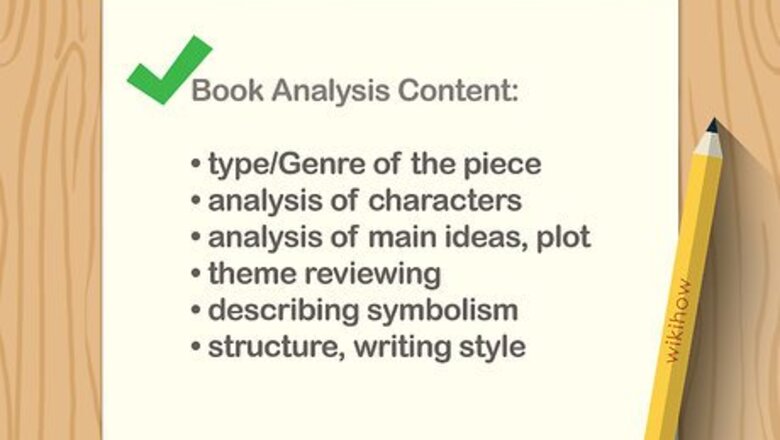
views
Breaking Down Fiction
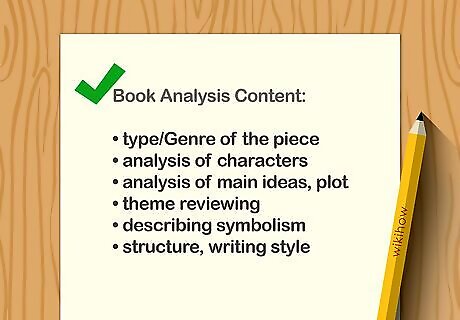
Read the work slowly and pay close attention to detail. To analyze a book for its subtle messages and ideas, you’ll need to give the book your undivided attention. Take your time as you’re reading and pay attention to all details the author chooses to include in the text. Remember when you’re reading that all the little details in the book were deliberately chosen by the author and hence might be significant in some unseen way. For example, if an author describes a young girl’s dress as “yellow like the sun,” ask yourself why the author chose the color yellow (symbol of optimism) or what it means for her dress to be compared to the sun. Certain sections of any book should be read with particular attention. The beginning and end, for example, are a good place to find meaning and symbolism in a text. Read these with a bit more attention. If you have trouble reading slowly or staying focused, try to keep the specific goal for your reading in mind instead of reading “mindlessly.” For instance, if you’re trying to analyze a work of fiction for symbolism, keep this in mind as you read and it will help you to zero in on the relevant details (e.g., the author’s choice of names for their characters). Read the book twice if you have time.
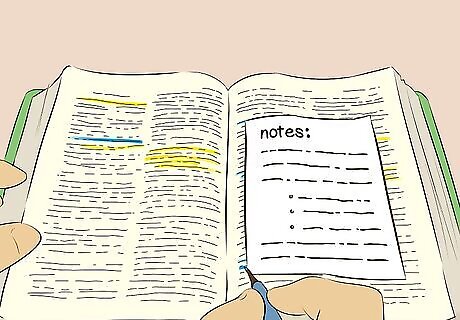
Take notes as you read. This will not only help you to note any details that appear to be significant, but will also allow you to jot down your thoughts as you read and keep them organized. Include page numbers and chapter numbers in your notes. Write down anything you think might be particularly important, even if you aren’t sure. You’ll be glad you kept a convenient record of potentially significant details when it comes time to write about your analysis. In your notes, quote directly from the book when you think the specific wording of the text is important. Otherwise, feel free to paraphrase the text when you’re taking note of events or themes. If you can, invest in a personal copy of the text. This lets you highlight, underline, and make notes in the margins of significant passages as you go.
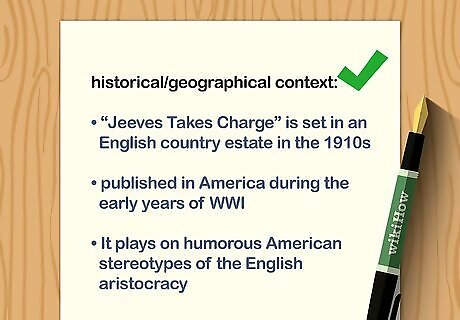
Study the context in which the author wrote the book. The work might be a commentary on events going on in the author’s life or be reflective of biases held by people in the author’s society. Knowing the context of the book may also help you determine what the author’s goal was in writing it. When researching the context in which a book was written, consider the time period, location (country, state, city, etc.), political system, and the biography of the author. For example, a Russian expat writing in the 1940s about a dictatorship may be making a statement on the Soviet Union or Joseph Stalin. Look into other books by the same author and see how the book you’re reading compares to them in terms of story, subject matter, themes, and other details. For example, many of Philip K. Dick’s novels focused on the nature of reality and questions surrounding identity. Try starting on a site like Wikipedia. While it's not an academic source, it often provides an overview of the topic and may link to other sources or even other works by the author.

Establish the essential plot points of the story. The plot of a novel is typically organized around a certain pattern which includes a problem, a climax, and a resolution. Identify where these points occur in the story to better understand what message the author is trying to get across. For example, if the characters in a novel are only able to resolve a problem by working together, the author may be making a statement on the importance of collaboration.
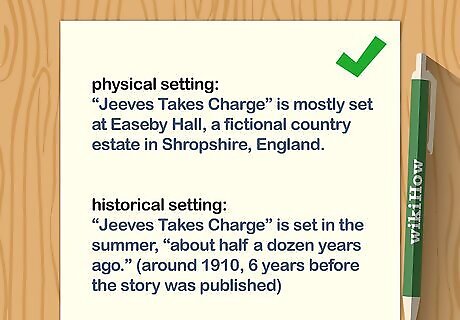
Determine the setting of the book and how it contributes to the story. Although the setting of a novel can seem like background, it's often as important to the story as some of the characters. Consider how the setting of the story influences your reaction to it or helps convey the story’s theme. Settings can be symbolic. Reflect on the characters at a certain point in their journey, and/or foreshadow certain key plot elements. For example, ask yourself if a story that takes place in an isolated cabin during winter would be significantly different if it took place in an apartment in a big city. If so, think about why a different setting changes the meaning of the story.
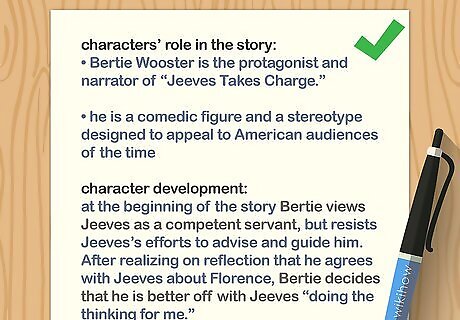
Examine the actions, motivations, and beliefs of the characters. Books typically have a main character (the protagonist), a villain (the antagonist), and an assortment of secondary characters. While reading, think about why the characters do what they do and what this says about them and their beliefs. You should also consider why the author would have their characters do the things they do and what point they’re trying to make. For example, if a holy man commits a murder, ask yourself why the character would betray his beliefs or why the author would seek to depict a holy man in this way.
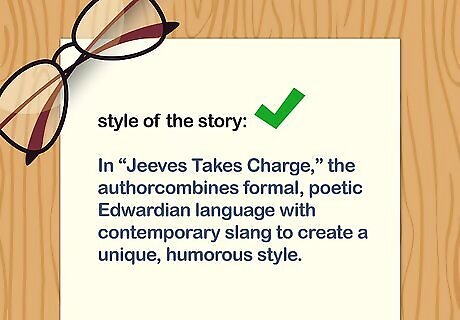
Consider how the author’s writing style affects the book’s story. Although an author’s writing style may be the result of personal preference, it could also be an intentional stylistic choice to influence a reader’s reaction to the story. Pay attention to the author's style and ask yourself if it influences the story’s meaning. Writing style includes the author’s choice of vocabulary, sentence structure, tone, imagery, symbolism, and overall feeling of the story. For example, an author may seek to impart a more humorous tone by using short, choppy sentences and nonsensical words.

Identify the book’s principal theme or message. Most authors who write a work of fiction will have a theme or message that they want their book to convey. Use your analysis of the plot, setting, characters, and writing style to determine what the book’s theme is. Some common themes include good vs. evil, growing up, human nature, love, friendship, war, and religion. A book may deal with multiple themes, with some themes being more obvious than others. Often, themes are most visible in the beginning and end of a book. Re-read these sections after your first read-through to help you evaluate the book's theme.

Make an outline to put your ideas and relevant information together. This is especially useful if you’re writing a critical analysis of a book for others to read. Create an outline that includes background information about the book and author, a summary or description of the work itself, and your interpretation.
Critiquing Non-Fiction Books
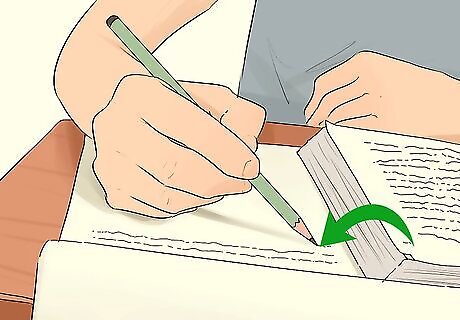
Read the book slowly and take notes as you read. Non-fiction books are often dense and can be dry to read. Make sure you read slowly and stay focused so you don’t lose track of the book’s logical flow. Jot down your thoughts on the book or the more important information you come across. Try to find key words and phrases in each paragraph as you read and write down a summary of each passage or chapter as you go. If you have trouble reading slowly or staying focused, try to keep the specific goal for your reading in mind instead of reading “mindlessly.” If you’re reading for specific information on a topic (e.g., the physical properties of meteorites), bear this in mind as you read and you will be better able to focus on the relevant information as you read it.
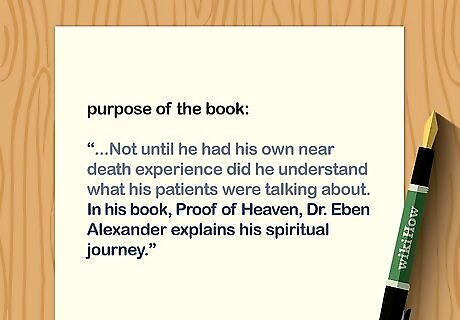
Determine the author’s purpose. Every non-fiction book has a purpose, whether it be to describe, persuade, argue, or instruct. Skim over the text and, if possible, read the book’s summary to discern what the author’s goal is. For example, some historians write books to challenge dominant interpretations of certain historical events (e.g., the cause of the American Civil War). Many authors will state the purpose of their non-fiction book in the preface or introductory chapter and restate that purpose in the book’s concluding chapter. Skim these sections to help you determine the book's overall goals.
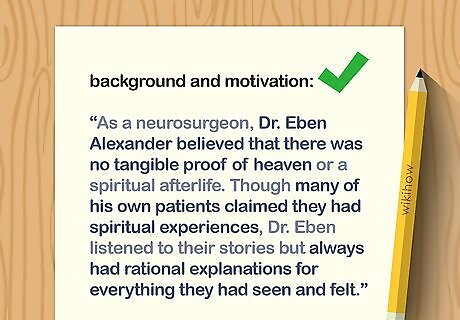
Research the author’s background and motivation for writing this book. Compare the book to other works that the author has written and ask yourself if the author’s beliefs or ideologies may result in the book being biased. For example, if the book is a history of a particular political party, then the author’s relationship to that party (e.g., if the author is a party member) will almost certainly influence how the party’s history is written in the book.
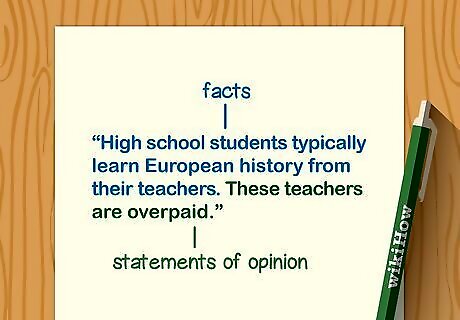
Distinguish facts from statements of opinion. Although the factual evidence used to bolster an argument should be viewed critically, it is the author’s opinion that you should critique and evaluate in your analysis. For example, an author may write: “High school students typically learn European history from their teachers. These teachers are overpaid.” In this instance, the first sentence is a statement of fact, while the second is a statement of opinion. Statements of fact are often followed by citations either in the form of footnotes or parenthetical citations. Don’t dismiss out of hand what an author says purely because it’s “opinion”; in most cases, an author’s conclusions will be derived from the facts that are also presented in the book and should be judged as such.
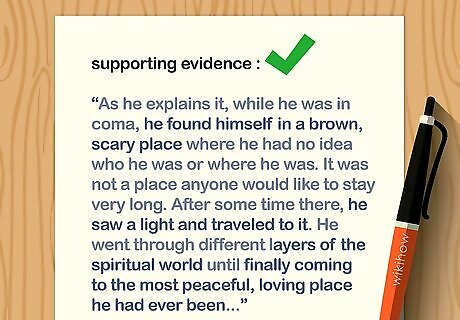
Examine the evidence the author relies on to support their argument. Determine whether the evidence the author presents actually supports their conclusions or persuades you to agree with their opinion. Similarly, consider whether the author has intentionally left out any evidence that contradicts their argument, due to their own bias. For example, consider whether you would reach a different conclusion based on the same evidence and check to see if the author describes in the book why they didn’t reach the same conclusion as you. If they don’t, their argument may not be entirely thought out. Try to check the author's information against other sources. Look at academic articles, online encyclopedias, and other scholarly resources to see if the evidence the author cites matches the larger scholarly body of work on the subject or if you can find contradictory evidence that the author did not include in their work.
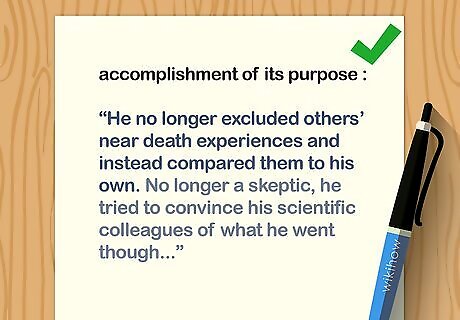
Decide whether the book accomplishes its purpose. Ask yourself if you’ve been convinced by the book to agree with the author’s opinion, argument, or conclusions. If you were not persuaded, determine what about the book failed to convince you of the author’s correctness. For instance, think about whether the author’s evidence was reliable or relevant, whether the argument was logical, and whether the author’s conclusions made sense to you. Be sure to not let your personal attitudes interfere with your analysis. If you find a book unconvincing, ask yourself if you have any internal biases that may prevent you from analyzing the book in a neutral manner.

















Comments
0 comment